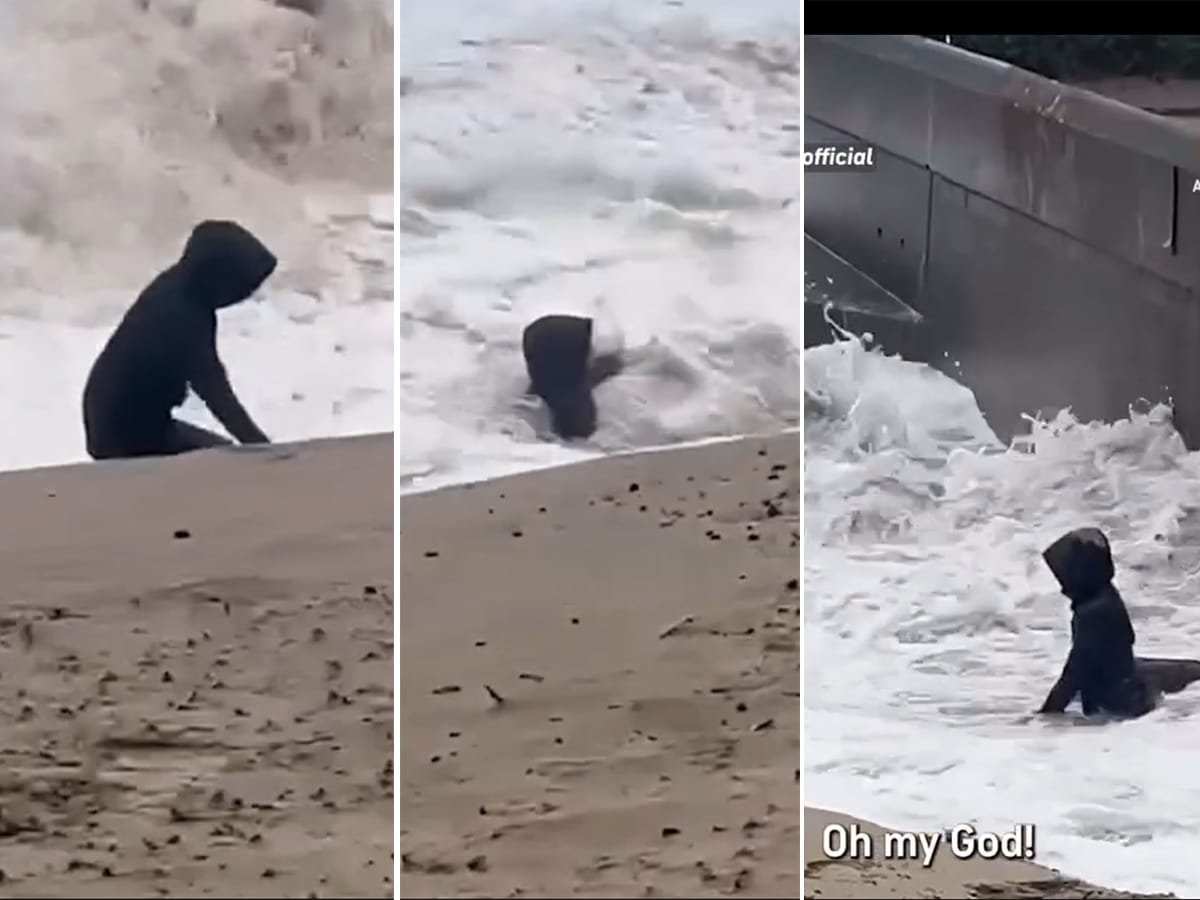
Moving into the central coast area of Oregon, I was impressed with the variety of seascapes I’d already seen (see part one and part two). But just about 30 miles out of Tillamook our road trip deposited me and Bill at Cape Kiwanda, a sandstone formation that’s very impressive.
With dramatic cliffs, rock towers and sea caves, Kiwanda is rated one of the best places on the Oregon coast to see the might of the waves. It also has a string of sandy beaches to the north and south, but the cape base is said to be very dangerous and has claimed multiple lives. It’s important to not go beyond any fenced-off areas anywhere along the coast, including those at Kiwanda. The tides come in quickly and off-limits, bluff-side vantage points can be tricky.
From Kiwanda, our adventure driving the Oregon coast continued south…

Pacifica City: Beer and spit hiking
Moving on and happily lunching on fish tacos and a brew at the Pelican Brewing in Pacific City, we watched a group of surfers ride the waves on either side of Haystock Rock #2 with the Great Sand Spit looming over the beach to the north. Hiking the massive sand spit is popular for the views offered at the top. On the beach below the pub, pedestrians should take heed because dory fishing boats sometimes plow right onto the beach blowing their horns and warning people of their approach at 10 knots an hour.
For beer enthusiasts, Pelican Pub serves between 10 and 16 home brews depending on the season. Almost any of them go well with the fish tacos, composed of pan-seared cod served with spicy Baja sauce, jicama lime slaw, pico de gallo, corn tortillas, and Southwest quinoa.

Lincoln City: Beach-combing on big beaches
With 7.5 miles of sandy beaches, Lincoln City has one of the longest stretches of beaches in the state. The town takes advantage of of this resource by offering visitors a chance to beach-comb and find (and keep) glass floats that “float fairy” volunteers hide along the shoreline daily. Year-round, local artisans make over 3,000 floats in various sizes. Visitors that find one can get an official certificate of authenticity with a simple phone call or online registration.
While in Lincoln City, a native advised me to make sure I stopped at Devil’s Punchbowl, about five miles south of Depoe Bay. Basically a large bowl with a small opening to the ocean, the circular rock formation empties at low tide, but soon fills with dangerous swirling, churning waters that make entry from the beach foolhardy and dangerous. I say stick to views from the top.
Pulling the car over at an overlook near Otter Crest Loop gave me a chance to spot my first whales of the trip. A pod of them could be seen fairly close to shore, gently rolling out of the ocean like mammoth dolphins and spouting sprays of water from their blowholes.
Historic and seaside Newport
On the way to Newport, we stopped at Yaquina Head Lighthouse, the state’s tallest at 93 feet. In 1872, it took approximately one year and over 370,000 bricks to construct the lofty structure. Visitors can register for guided tours at the Interpretive Center, which also has exhibits about the history and preservation of the lighthouse and the marine life found in adjacent tide pools and along the coast.
A little before dusk, we checked into Elizabeth Oceanfront Suites in Newport and sat on the balcony for a few minutes watching the sun slowly sink over the horizon with bursts of gorgeous color. Later, a drive down to Newport’s historic bayfront gave us a look at some of the still-operating canneries and seafood processing enterprises. Besides restaurants and artisan galleries, the bayfront is home to Wax Works, Ripley’s Believe It or Not and the Pacific Maritime Heritage Center. Across the street, a moored glass-bottom boat allows you to walk down to the depths of the hold and see a large collection of local marine life in the “Undersea Garden” through large glass windows. Alongside the boat marina, the docks are gathering places for large numbers of sea lions, who croak and bark at one another in seemingly non-stop fashion.
On your way south out of Newport, you’ll drive across the visually appealing Yaquina Bay Bridge, an arch bridge that’s one of 11 major bridges along the Oregon Coast Highway. If you have time, you can walk across the bridge to South Beach and the Oregon Coast Aquarium, consistently ranked one of the top ten aquariums in the nation. Indoor and outdoor exhibits feature animals of the Oregon coast and the large open-air aviary is home to sea birds like puffins and murres.
A nice bite to eat in Yachats
Hungry after a short drive south, we stopped at Yachats Brewing and Farmstore for lunch. Very hipsterish, the establishment is one hippies from the 1960s would feel comfortable in. As we chomped down on a fermented vegetable plate appetizer (a quartet of red horse kraut, traditional kraut, kimchi, and cortido, which is Salvadoran-style kraut served with cornmeal crepes), we listened to sales manager Zink Ham tell us about the building, a transformed 1965 bank. Much of the remodeling was done with recycled materials like old-growth Douglas fir timbers salvaged from a locomotive shop in Portland, and furniture built with reclaimed wine barrels.
For our entrees, my photographer had a beet (yes, beet not beef) burger he relished, and I munched on koa man gai, sous vide chicken served with jasmine rice, kimchi, and radish salad and sauced with spicy fermented soybean sauce. We washed everything down with glasses of sea buchkthorn and guava melon kombucha, two of the three on tap and made in-house.
The highest accessible point on the Oregon coast (802 feet) and the nation’s largest sea cave
On the way to Florence, we stopped at Cape Perpetua, at 802 feet the highest point on the Oregon coast accessible by car. From the apex, visitors can see 70 miles of Oregon coastline and 37 miles out to sea. With nearly 27 miles of hiking trails, the cape features tide pools, water spouts, jagged cliffs, and a nearly 600-year-old Sitka spruce tree, said to be the state’s largest. After a brief stop at Heceta Head Lighthouse, we walked past the assistant lightkeeper’s house, now a charming bed and breakfast. I wish I’d known about it before my trip started and tried to book a room for the night.
Even further south is Sea Lions Cave, a commercial establishment that’s home to the nation’s largest sea cave, which charges $14 for an adult admission ticket, $8 for children (ages five to 12). After exiting the reception area, you walk down a long sidewalk to an elevator that takes you down to the cave. It’s nicely lit, though dim, so you can look over the capacious cave through glass windows. The sea lions are usually plentiful during the winter months, but in the spring they move out onto the rock ledges in front of the cave to breed and birth their young.

Florence: An old town on the Siuslaw River
Arriving in Florence, we checked into the River House Inn, located on the Siuslaw River and within walking distance of the old town. For a few minutes we sat outside on the terrace and watched the boat traffic move up and down the river. Before dinner, the beautiful Siuslaw River Bridge proved enticing enough to pull us in for a walkover. Later, we soaked in the ambient charm of the shops and streetscape of the old village before heading into Bridgewater Fish House and Zebra Bar.
Built in 1901 to house a hardware and general store as well as the town’s first post office, this two-story, white, clapboard building really stands out on the street architecturally. It morphed into a restaurant in the late 1980s and has a rustic, comfortable decor. The menu is eclectic enough to satisfy most tastes, and many items are made from scratch. There’s live music Friday through Sunday evenings and bottled wine is half price on Wednesdays.
In part four: Florence to Medford.
For more information on the Oregon coast, visit traveloregon.com.




Great post! I went to Hillsborough last summer. On the way, I drove through some of these places. Your article reminded me of my journey.